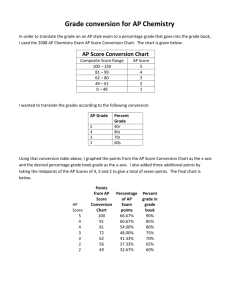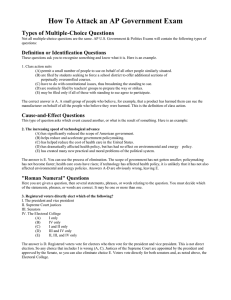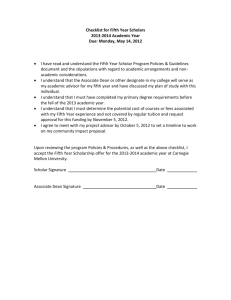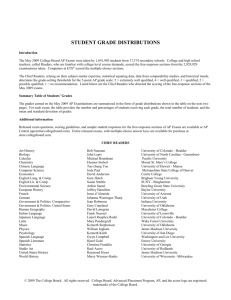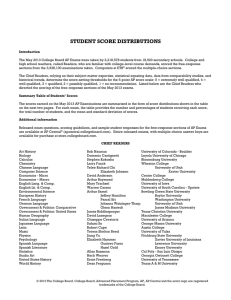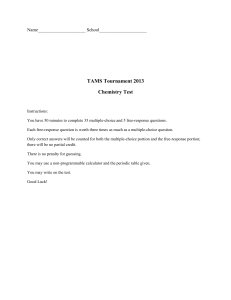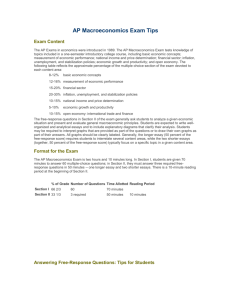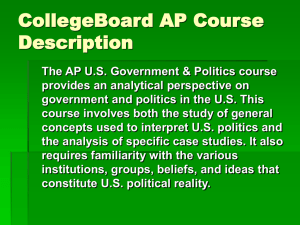AP Gov Test Taking Tips - Dr. Cash's AP US Government
advertisement
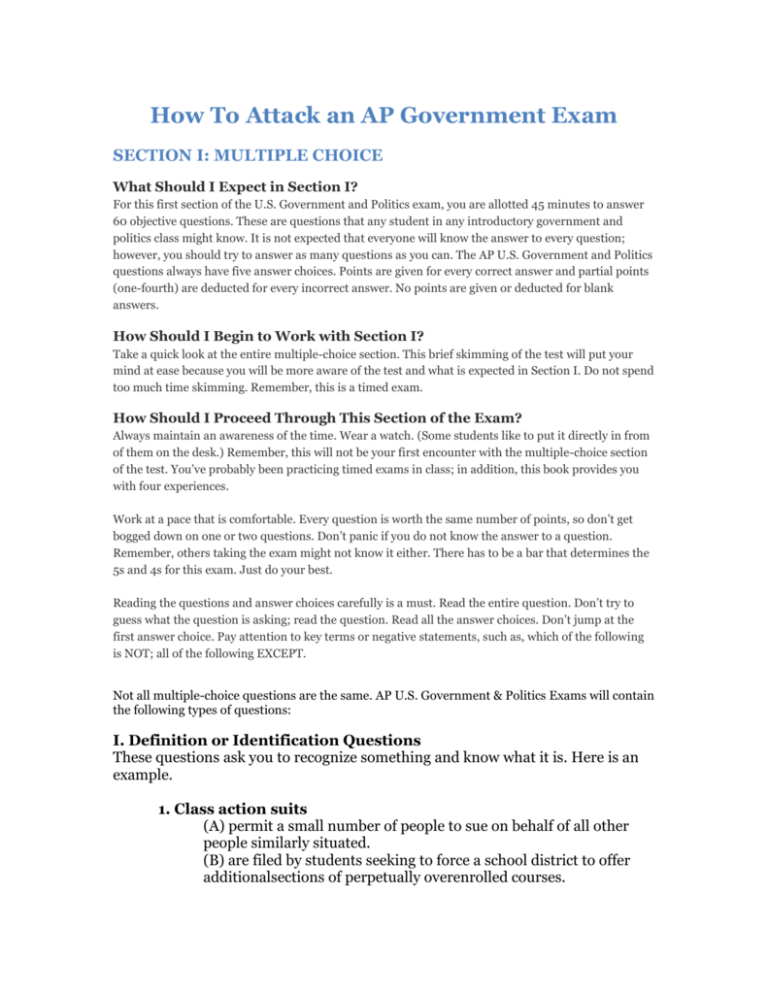
How To Attack an AP Government Exam SECTION I: MULTIPLE CHOICE What Should I Expect in Section I? For this first section of the U.S. Government and Politics exam, you are allotted 45 minutes to answer 60 objective questions. These are questions that any student in any introductory government and politics class might know. It is not expected that everyone will know the answer to every question; however, you should try to answer as many questions as you can. The AP U.S. Government and Politics questions always have five answer choices. Points are given for every correct answer and partial points (one-fourth) are deducted for every incorrect answer. No points are given or deducted for blank answers. How Should I Begin to Work with Section I? Take a quick look at the entire multiple-choice section. This brief skimming of the test will put your mind at ease because you will be more aware of the test and what is expected in Section I. Do not spend too much time skimming. Remember, this is a timed exam. How Should I Proceed Through This Section of the Exam? Always maintain an awareness of the time. Wear a watch. (Some students like to put it directly in from of them on the desk.) Remember, this will not be your first encounter with the multiple-choice section of the test. You’ve probably been practicing timed exams in class; in addition, this book provides you with four experiences. Work at a pace that is comfortable. Every question is worth the same number of points, so don’t get bogged down on one or two questions. Don’t panic if you do not know the answer to a question. Remember, others taking the exam might not know it either. There has to be a bar that determines the 5s and 4s for this exam. Just do your best. Reading the questions and answer choices carefully is a must. Read the entire question. Don’t try to guess what the question is asking; read the question. Read all the answer choices. Don’t jump at the first answer choice. Pay attention to key terms or negative statements, such as, which of the following is NOT; all of the following EXCEPT. Not all multiple-choice questions are the same. AP U.S. Government & Politics Exams will contain the following types of questions: I. Definition or Identification Questions These questions ask you to recognize something and know what it is. Here is an example. 1. Class action suits (A) permit a small number of people to sue on behalf of all other people similarly situated. (B) are filed by students seeking to force a school district to offer additionalsections of perpetually overenrolled courses. (C) have to do with constitutional issues, thus broadening the standing to sue. (D) are routinely filed by teachers' groups to prepare the way or strikes. (E) may be filed only if all of those with standing to sue agree to participate. The correct answer is A. A small group of people who believe, for example, that a product has harmed them can sue the manufacturer on behalf of all the people who believe they were harmed. This is the definition of class action. II. Cause-and-Effect Questions This type of question asks which event caused another, or what is the result of something. Here is an example: 2. The increasing speed of technological advance (A) has significantly reduced the scope of American government. (B) helps reduce and accelerate government policymaking. (C) has helped reduce the cost of health care in the United States. (D) has dramatically affected health policy, but has had no effect on environmental and energy policy. (E) has created many new practical and moral problems of the political system. The answer is E. You can use the process of elimination. The scope of government has not gotten smaller; policymaking has not become faster; health care costs have risen; if technology has affected health policy, it is unlikely that it has not also affected environmental and energy policies. Answers A-D are obviously wrong, leaving E. III. "Roman Numeral" Questions Here you are given a question, then several statements, phrases, or words relating to the question. You must decide which of the statements, phrases, or words are correct. It may be one or more than one. 3. Registered voters directly elect which of the following? I. The president and vice president II. Supreme Court justices III. Senators IV. The Electoral College (A) I only (B) IV only (C) I and II only (D) III and IV only (E) II, III, and IV only The answer is D. Registered voters vote for electors who then vote for the president and vice president. This is not direct election. So any choice that includes I is wrong (A, C). Justices of the Supreme Court are appointed by the president and approved by the Senate, so you can also eliminate choice E. Voters vote directly for both senators and, as noted above, the Electoral College. IV. EXCEPT or NOT Questions In this type of question, four of the answer choices are correct, and you must find the answer that is wrong. Be sure to read the question carefully. Here is an example of this type of question. 4. Which of the following is NOT specifically mentioned in the Constitution, including its amendments? (A) Protection against double jeopardy (B) Right to bear arms (C) Freedom of speech (D) Right to privacy (E) Right to trial by jury The answer is D. Double jeopardy is addressed in the Fifth Amendment. The right to bear arms is mentioned in the Second Amendment. Freedom of speech is protected by the First Amendment. Article III provides for trial by jury. Only the right to privacy is not specifically mentioned in the Constitution. Supreme Court Decisions You will be asked to identify, interpret, or compare one or more well-known Supreme Court decisions. Here is an example: 5. New York Times v. Sullivan addressed (A) equal opportunity in the workplace. (B) libel. (C) prior restraint. (D) business monopolies. (E) obscenity. The answer is B. The Court held that statements about public figures are libelous only if made with "reckless disregard for the truth." There is no way to guess here. All the choices are topics the Supreme Court has ruled on, and all might involve a newspaper. You need to remember significant cases and the issues they address. V. Graphic Questions You can expect to see questions based on graphs, tables, and maps. DISTRIBUTION OF INCOME AMONG FAMILIES Lowest fifth Second fifth Third fifth Fourth fifth Highest fifth (percentage share by economic level) 1970 1980 1990 2000 5.5 5.1 4.6 3.6 12.0 11.6 10.8 8.9 17.4 17.5 16.6 14.9 23.5 24.3 23.8 23.0 41.6 41.6 44.3 49.6 6. Which of the following conclusions about income distribution is supported by the table? (A) The share of income received by the lowest fifth increased, and the share received by the fourth fifth decreased. (B) The share of income received by the second fifth increased, and the share received by the fourth fifth decreased. (C) The share of income received by the highest fifth increased, and the share received by the lowest fifth decreased. (D) The number of people earning high incomes increased. (E) The middle class disappeared. The numbers clearly show that C is the answer. Choice D might be attractive, but note that the table gives percents. Although the percent of families in the highest fifth increased, you know nothing about the actual number of people. Always read the questions and answer choices carefully. Read every answer choice carefully before you make your final selection. Use the process of elimination to help you choose the correct answer. Even if you are sure of an answer, cross out the letters of incorrect choices in your test booklet as you eliminate them. This cuts down on distraction and allows you to narrow the remaining choices even further. If you are able to eliminate three answer choices, it is better to make an educated guess at the correct answer than to leave the answer blank. If you can only eliminate one or two answers, leave the answer blank: you are more likely to lose a point by guessing between more than two answers. Every question is worth the same number of points, so don’t get bogged down on one or two questions. Don’t panic if you do not know the answer to a question. Remember, others taking the exam might not know it either. There has to be a bar that determines the 5s and 4s for this exam. Just do your best. Reading the questions and answer choices carefully is a must. Read the entire question. Don’t try to guess what the question is asking; read the question. Read all the answer choices. Don’t jump at the first answer choice. Pay attention to key terms or negative statements, such as, which of the following is NOT; all of the following EXCEPT. Strategies for Answering the Multiple-Choice Questions You probably have been answering multiple-choice questions most of your academic life, and you’ve probably figured out ways to deal with them. However, there may be some points you have not considered that will be helpful for this particular exam. General Guidelines Work in order. This is a good approach for several reasons: — It’s clear. — You will not lose your place on the scan sheet. —There may be a logic to working sequentially that will help you answer previous questions. But this is your call. If you are more comfortable moving around the exam, do so. Write on the exam booklet. Mark it up. Make it yours. Interact with the test. Pace yourself and watch your time. Don’t spend too much time on one question so that you run out of time and don’t complete questions you might know, but which appear later in the exam. Don’t rush. There are no bonus points for finishing early. Don’t be misled by the length or appearance of a question or of answer choices. There is no correlation between length or appearance and the difficulty of the questions. Read the questions and answer choices carefully. Make note of key terms such as NOT or EXCEPT. Consider all the choices in a given question. This will keep you from jumping to false conclusions. It helps you slow down and really consider all possibilities. You may find that your first choice is not the BEST or most appropriate choice. Remember that all parts of an answer must be correct for the answer to be correct. Specific Techniques 1. Read the five choices. 2. If no choice immediately strikes you as correct, you can — eliminate those that are obviously wrong — eliminate those choices that are too narrow or too broad — eliminate illogical choices — eliminate answers that are synonymous (identical) — eliminate answers that cancel each other out 3. If two answers are close, do one or the other of the following: — Find the one that is general enough to cover all aspects of the question. — Find the one that is limited enough to be the detail the question is looking for. Educated guess. You have a wealth of skills and knowledge. A question or choice may trigger your memory. This may form the basis of your educated guess. Have confidence to use the educated guess as a valid technique. Trust your own resources. Effective with the 2011 AP exam, points on the multiple choice section of the test are no longer deducted for incorrect answers. Therefore, it is to your advantage to guess on every question when you are not sure of the correct answer. Last But Not Least 1. Knock out the stupid answers- Many multiple choice questions on an AP exam have at least one wild-card answer that looks nothing like any of the others and couldn't possibly be right. Anyone even a little familiar with the exam content won't choose it. Cross that one out first. 2. Knock out the answer that's "almost" right- Examiners know that some people will look at the question, have a quick think and look for the answer that's in the ball-park. That's why they include an answer choice that's only half-right. Half-right is WRONG and it's a "trick" answer put in to fool you. Find that answer and cross it out next. Section II: Free-Response Questions The free response section consisting of four questions, i.e., You may, however, have some choice within a question. Because the free-response questions are open-ended, this is your opportunity to demonstrate your understanding of U.S. government and politics. You will see directives like define, identify, describe, and explain. Knowing facts or terms may earn you points if the task is to define or to identify, but to describe or to explain requires using your knowledge to construct an argument. You should use your knowledge to construct a thorough and intelligent response. Scan all questions quickly to form initial impressions of the topics about which you are being asked to write. You do not have to answer the questions in the order in which they are presented. Begin with the question you think you can respond to best. (If you are to run short on time, you would rather run short on a question about which you think you know the least, than the one about which you know the most.) Read and reread the question to be sure you understand exactly what is being asked. Underline directives such as define, identify, describe, and explain. These are the tasks that must be accomplished for you to earn credit for a response. You can jot notes in the margins of the exam booklet. Take a couple of minutes to brainstorm about the topic. Write down the things that come to your mind. Then look them over to see which ideas will go well together to serve as examples for your response to the question and to determine the order in which you will present them. This, in essence, is the outline for your response. You may use any organizational approach that makes sense to you as long as you respond to the question and all of its parts. Strong organization is to your advantage. Using the question structure as your guide is often a very good approach; think carefully before doing something more creative, as it makes it more difficult for you (and for the reader!) to see that you have answered the entire question. Now you are ready to begin writing. What you write is the only evidence that the reader has about what you know regarding the question that has been posed. You will not get any benefit of the doubt about your knowledge. Flesh out the ideas you used to construct your outline, using precise language and examples to bolster you points. Correctly used, appropriate examples give the reader confidence that you have an understanding of the question that merits awarding the points allocated to that part of the question. Your answer will be judged based on whether or not you have accomplished your task-to define, identify, describe, or explain-as laid out in the question. You earn points for accomplishing the assigned tasks. There is no need to venture beyond the scope of the question. You will not earn extra points, and, because each question is scored independently, you will not be able to make up for a question you feel you did not answer well enough by overcompensating on another question. Many free-response questions on an AP U.S. Government & Politics Exam will ask you to address a single topic in a straightforward way. Here is an example of such a question: 1. The system of checks and balances ensures that no branch of government has unfettered power. Describe-using examples-how each branch has exercised this power over another branch. In your response to this question, you need to furnish examples that help you describe how each of the three governmental branches has used the system of checks and balances to wield power. Some free-response questions are divided into several parts, or sub questions. You might be presented with a list of items, such as specific court cases or interest groups, that you are asked to address in your response. These partitioned questions often contain directives like identify, describe, and explain. Here is an example: 2. Choose two of the following Supreme Court cases. California Board of Regents v. Bakke Roe v. Wade Gideon v. Wainwright Rust v. Sullivan Miranda v. Arizona Korematsu v. United States For each case you selected, do each of the following. a. Describe the position of each side. b. Describe the Supreme Court's ruling. c. Explain whether the ruling increased or decreased the rights of individuals. First, you need to recognize (at least two of) the cases and choose the two you want to use in the remainder of your response. Do not be intimidated by a list of six cases. You could know absolutely nothing about four of the cases and still earn all of the points for the question. Second, you would need to describe the positions of the opposing sides in each of the two cases chosen (four descriptions). Third, you must describe the Court's ruling, i.e., present a simple statement of the Court's holding in the cases chosen. Finally, you must take a position on whether the rights of individuals were increased or decreased in each of the chosen cases and support your position. A simple statement of your conclusion about the increase or decrease of individual rights by the Court in your chosen cases would not be sufficient to earn credit for the explain part of the question. The reader must finish your response knowing how you think rights were expanded or contracted or why you have taken the position you have for each of the chosen cases. It is often the explain part of a question that separates the best prepared students from the rest. It cannot be overemphasized: pay close attention to exactly what the question asks you to do, and do it-nothing more, nothing less! For example, in the question posed above, asking you to describe the positions of the parties in two cases, the Supreme Court's ruling, and to explain the cases' impact on the expansion or contraction of individual rights, you might know the full story of Clarence Gideon and how his case made it to the Supreme Court, but even a brilliant explanation of this saga would earn you no points because that is not requested in the question. To earn points, answer the question that is asked-not the one you wish had been asked. You will not be asked about your personal political opinions, so do not include them in your answer. You do not get extra credit for going beyond the scope of a question, and that just wastes your valuable time. Similarly, students sometimes will write a response that is completely off topic when they don't know the answer. You are better off re-reading your other answers and adding to them if you can't write on one of the questions. But even writing a little on a topic might earn a few points that a description of your prom night (and yes, some essays do exactly that!) won't. The AP Exam is a political science exam. Make sure that your answer is a political science answer. Strategies for Free-Response Questions Here is a list of strategies that you can use to increase your chance of excelling on the free-response section of the exam. Some frequently used directives are listed below, along with descriptions of what you need to do in writing your answer. • compare: address similarities and differences between two or more things • describe: give a detailed account • identify: give a brief definition or listing • explain: communicate how or why Read the Questions Carefully This applies to both multiple-choice and free-response questions. For multiplechoice questions it is important for students to read the question carefully to look for words such as "NOT" and "EXCEPT." For free-response questions it is important that students respond to ALL PARTS of the question being asked. Understanding what is being asked and responding with specific evidence is a very useful skill. Long, involved descriptions full of random facts about a specific concept or political phenomenon are neither encouraged nor rewarded in the grading process; students must be taught to "read for the guidelines" in order to make sure both their information and presentation clearly and completely answer the actual question that is being asked. Understand the Instructions and Action Verbs Students may be asked to list, discuss, describe, explain, analyze, etc.; these are not all identical tasks. Also, the question may call for more than one task, such as both to identify and explain. Students should understand that some tasks are more complex than others. For example, composing a list may not even require a complete sentence, but students may need to write several paragraphs for a satisfactory discussion, including well-developed examples as support, in order to adequately explain some phenomenon. Here are some of the most common action words used in past free-response questions: List/Identify: Listing or identifying is a task that requires no more than a simple enumeration of some factors or characteristics. A list does not require any causal explanations. For example, a student might be asked to list or identify three factors that increase political legitimacy. Such a list could be bulleted or numbered, and might include such factors as a written constitution, competitive elections, and transparent institutions. Define: A definition requires a student to provide a meaning for a word or concept. Examples may help to demonstrate understanding of the definition. Students may be instructed to note the term's significance as part of the definition. Describe: A description involves providing a depiction or portrayal of a phenomenon or its most significant characteristics. Descriptions most often address "what" questions. For example, if students are asked to describe a political cleavage in Mexico, they must demonstrate knowledge that the cleavage has at least two sides by describing what the two sides are. Discuss: Discussions generally require that students explore relationships between different concepts or phenomena. Identifying, describing, and explaining could be required tasks involved in writing a satisfactory discussion. Explain: An explanation involves the exploration of possible causal relationships. When providing explanations, students should identify and discuss logical connections or causal patterns that exist between or among various political phenomena. Compare/Contrast: This task requires students to make specific links between two or more concepts, occurrences, or countries. Thus, students cannot simply have a one-paragraph description of how women participate in Iranian politics and a one-paragraph description of how they participate in Nigeria with no connections between the two paragraphs. To correctly compare participation of women in Nigeria and Iran there must be cross paragraph references and development of a comparative structure. The students must provide the connective tissue. They should understand that it is important to note similarities AND differences. Evaluate/Assess: An evaluation or assessment involves considering how well something meets a certain standard, and as such generally requires a thesis. It is important to identify the criteria used in the evaluation. If no criteria are explicitly given in the question, students should take care to clearly identify the ones that they choose to employ. Specific examples may be applied to the criteria to support the student's thesis. Evaluation or assessment requires explicit connections between the thesis or argument and the supporting evidence. Analyze: This task usually requires separating a phenomenon into its component parts or characteristics as a way of understanding the whole. An analysis should yield explicit conclusions that are explained or supported by specific evidence and/or well-reasoned arguments.
